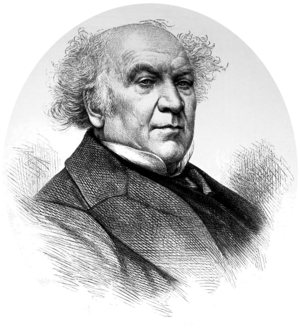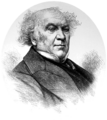James Murray (physician) facts for kids
Sir James Murray (1788–1871) was an Irish doctor who made a big discovery: Milk of Magnesia. He found this stomach medicine in 1809 while studying how our bodies digest food. He also researched how electricity might affect health and was the first doctor to suggest breathing in iodine vapor for lung problems.
Born in Derry, Murray studied medicine and became skilled in making medicines. In 1809, he created "Fluid Magnesia." This medicine helped with "weak nerves," mild fevers, muscle spasms, cholera, and diarrhoea. He started a company called Sir James Murray & Son to sell his new medicine.
Murray became a full doctor in 1829. He later worked as the personal doctor for an important leader, Henry Paget, 1st Marquess of Anglesey. He was made a knight in 1833, which meant he could use "Sir" before his name. He also received an honorary degree from Dublin University. Murray helped check on medical schools in Ireland and was part of the main health board.
Sir James Murray passed away in Dublin on December 8, 1871. He is the great-grandfather of the famous English actor Michael Hordern.
Contents
About Sir James Murray
His Early Life and Studies
James Murray was born in Derry, a city in Ireland. His parents were Edward and Belinda Murray. He went to the Edinburgh College of Surgeons in Scotland. In 1807, he became a qualified midwife, which is someone who helps deliver babies.
While studying, Murray listened to lectures by John Dalton. Dalton was a famous scientist who studied chemistry, physics, and weather. Murray became interested in how heat and electricity naturally work inside living things. After finishing his studies, Murray became a doctor at a hospital in Belfast. A powerful person named George Chichester, 3rd Marquess of Donegall, who owned Belfast Castle, supported his career.
The Story of Milk of Magnesia
Around 1809, Murray created the first version of his "Fluid Magnesia." This medicine became very popular as a stomach aid. Its main ingredient was Magnesium sulfate, which had long been known to help with digestion and constipation (trouble going to the bathroom).
Murray called his invention Fluid Magnesia. He started a company, Sir James Murray & Son, to sell it successfully. Fluid Magnesia was later sold as a liquid. It was recommended as a tasty laxative (a medicine to help you go to the bathroom). It also helped with acidity (too much stomach acid), indigestion (upset stomach), heartburn, and gout (a type of arthritis).
Murray also made a sweet-tasting syrup to mix with the fluid. This made the medicine taste better, which was especially good for women and children. He also sold "Sir James Murray's Pure Fluid Camphor." This was a tonic (a medicine to make you feel stronger) used for "weak nerves," mild fevers, muscle spasms, cholera, and diarrhoea.
Some other doctors at the time criticized Murray. They thought he was too focused on making money from his inventions. Murray only protected his formula in the British Empire. This meant others outside the empire could copy his medicine. He had to go to court many times to protect his rights. After Murray died, his assistant, Dinnisford, became rich by selling a popular version of the formula.
Fertilizer for Plants
Sir James Murray was also interested in making better fertilizers for farming. Fertilizers help plants grow. On May 23, 1842, Murray received a patent for a special type of fertilizer called superphosphate. A patent protects an invention, so others can't copy it without permission.
On the very same day, another person named John Bennet Lawes also got a patent for superphosphate. However, Murray's patent was given priority. This was because he had been working on superphosphate since 1808, much earlier. Superphosphate is a form of phosphate rock that dissolves easily. This makes the important nutrient phosphate available for plants to use.
His Achievements and Recognition
In 1829, Murray earned his degree as a Doctor of Medicine from the University of Edinburgh. In 1831, he became the personal doctor to the lord lieutenant of Ireland, Henry Paget, 1st Marquess of Anglesey.
In 1833, his employer made Murray a knight. This honor meant he could use "Sir" before his name. The next year, he received an honorary medical degree from Dublin University. He was also chosen to inspect medical schools in Ireland. He was a member of the central board of health, which helped manage public health.
Studies on Heat and Electricity
Murray worked as a doctor at the Netterville Dispensary and the Anglesey Lying-In Hospital in Dublin. He was the first doctor to suggest that people with breathing problems should breathe in iodine mixed with water vapor.
In 1829, he published a paper about how heat and humidity affect the body. He also wrote about breathing in iodine. This paper was reissued later with new information about his technique for tracheotomy operations. A tracheotomy is a medical procedure to create an opening in the windpipe to help someone breathe.
Murray's report looked at body temperatures in different diseases. He also studied how heat and liquids affected medicines. He believed that diluting (thinning out) most medicines made them work better.
However, Murray was most interested in electrotherapy, which is using electricity for medical treatment. He wrongly believed that electricity caused cholera and other widespread diseases. He thought that these diseases happened when the body had too much or too little natural electricity.
During the cholera outbreak of 1832, he tried to help patients by lowering the air pressure around their bodies. He used a special air pump he designed. He also supported using air pressure in "air baths" for medical reasons. He shared his findings in various medical journals.
His Family Life
In 1809, Murray married Mary Sharrock. They had several children together. After she passed away, he married Mary Allen in 1848. They had one daughter. Sir James Murray is the great-grandfather of the actor Michael Hordern.
Murray died at his home in Dublin on December 8, 1871. He was buried at Glasnevin Cemetery in Dublin.
Images for kids



